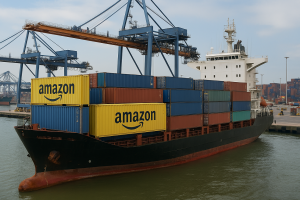Ever Wondered How Your Amazon Package Arrives So Fast?
In an era of same-day shipping and lightning-fast e-commerce, have you ever stopped to consider how your Amazon order travels halfway across the world in days—or even hours? While digital interfaces and fulfillment centers are highly visible components of the Amazon experience, the real powerhouse behind global e-commerce lies in maritime logistics. Ships—particularly container vessels—are the unsung heroes of global trade, and they play a vital role in delivering Amazon packages to your doorstep.

What Is Maritime Shipping?
Maritime shipping refers to the transportation of goods via sea routes using various types of vessels such as container ships, bulk carriers, and roll-on/roll-off (Ro-Ro) ships. This mode of transport is crucial for international trade, as more than 80% of the world’s traded goods—by volume—are carried by sea, according to the International Maritime Organization (IMO).
Amazon and Ocean Freight: A Deep Dive
Amazon is not just a tech or logistics company—it’s also a growing player in global shipping. Over the past few years, Amazon has taken significant steps to control more of its shipping and freight operations:
- Amazon Global Logistics (AGL): A division responsible for moving products from China and Southeast Asia to Amazon warehouses in Europe and North America.
- Private Ocean Freight Operations: Amazon now operates as a licensed Non-Vessel Operating Common Carrier (NVOCC), which allows it to book ocean freight independently.
- Shipping Partnerships: Amazon contracts major shipping companies like Maersk, MSC, and COSCO to move its high-volume cargo.
Container Ships: The Engine Behind E-Commerce
Large container vessels carry thousands of TEUs (Twenty-foot Equivalent Units) filled with everything from books and electronics to apparel and home goods. These ships are specially designed for speed, cargo security, and optimized logistics.
- Transit Time: From China to the U.S. West Coast takes about 12-20 days.
- Intermodal Hubs: Ports like Los Angeles, Rotterdam, and Singapore act as critical transfer points.
- Environmental Concerns: Amazon is now focusing on low-emission freight solutions, including alternative fuels and carbon offsets.
Key Ports for Amazon Deliveries
Some of the major ports facilitating Amazon’s global deliveries include:
- Port of Shanghai (China)
- Port of Rotterdam (Netherlands)
- Port of Los Angeles & Long Beach (USA)
- Port of Hamburg (Germany)
These ports are integrated into Amazon’s supply chain using advanced maritime logistics software and automated terminal operations.
Challenges Faced by Maritime Logistics
Despite its scale, maritime shipping faces several challenges:
- Port Congestion: Especially during peak seasons.
- Sustainability Pressures: The IMO’s carbon regulations are tightening.
- Geopolitical Risks: Conflicts like the Ukraine war or Red Sea disruptions affect shipping routes.
- Labor Shortages: Dockworkers and ship crew shortages can delay port operations.
The Future: Greener and Smarter Shipping
Amazon and the shipping industry are working towards greener shipping methods:
- Alternative Fuels: LNG, biofuels, and hydrogen are being tested.
- Autonomous Ships: AI-powered vessels for efficient navigation and safety.
- Carbon-Neutral Goals: Amazon aims to reach net-zero carbon by 2040.
These advancements align with the global Maritime Decarbonization Initiatives, part of broader environmental strategies like the IMO 2023 regulations.
Why It Matters for Maritime Students and Professionals
Understanding the dynamics between e-commerce and shipping provides key insights for anyone pursuing a maritime career:
- Cadets & Students: Gain insight into global shipping trends.
- Ship Officers: Learn about evolving vessel technologies.
- Shipping Companies: Identify partnership opportunities with e-commerce giants.
Conclusion: The Invisible Hand of the Sea
Maritime transport is the silent force behind our digital shopping sprees. From the factories in Asia to fulfillment centers in Europe and America, ships make Amazon’s delivery promises possible. As maritime technology evolves, it’s vital for professionals to understand this transformation.
Learn more:
- How Amazon Operates Its Global Logistics
- IMO and Sustainable Shipping
- Introduction to Maritime Logistics – MaritimeEducation.com
- What is a Container Ship? – MaritimeEducation.com
FAQs
Q1: How does Amazon ship from China?
A1: Amazon uses its own logistics division and partners with ocean freight carriers to import goods.
Q2: Are ships faster than air cargo for Amazon deliveries?
A2: No. Air cargo is faster but significantly more expensive. Ships are ideal for cost-effective, bulk deliveries.
Q3: Will ships continue to be relevant with drone and AI technologies?
A3: Absolutely. Even with new tech, ships remain the backbone of mass cargo transportation.
Q4: How do container ports support Amazon?
A4: Ports provide crucial logistics services such as storage, customs clearance, and intermodal transfer.

